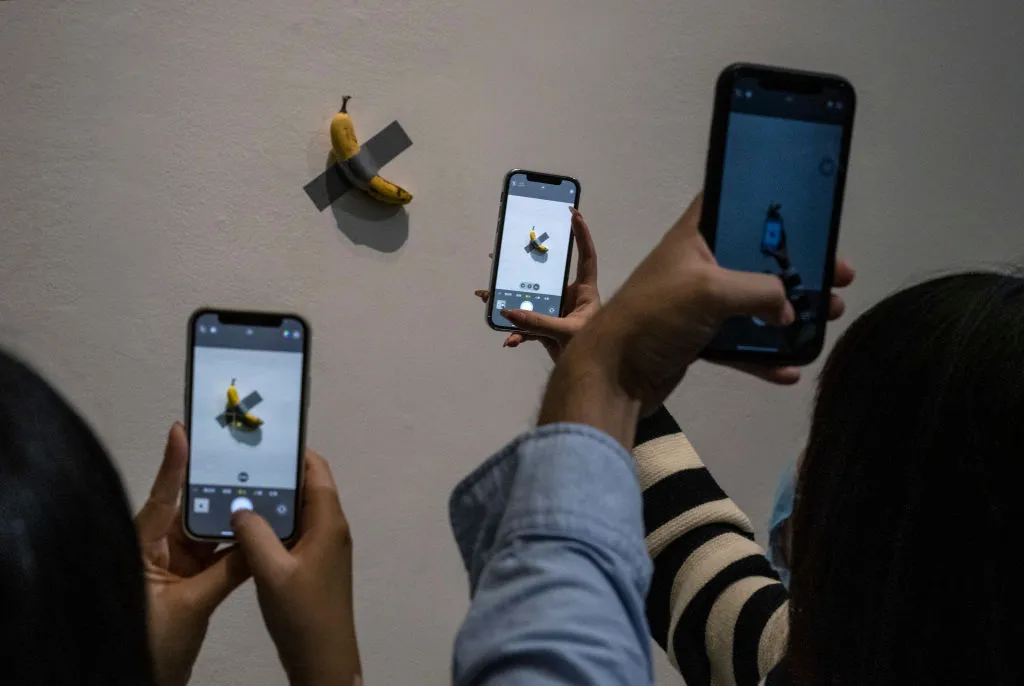
To receive Morning Links in your inbox every weekday, sign up for our Breakfast with ARTnews newsletter.
The Headlines
GOING BANANAS. Maurizio Cattelan’s famously provocative duct-taped, yellow plantain sculpture will be auctioned at Sotheby’s in New York on November 20. Has the piece managed to retain its crowd-drawing a-peel? These are the irresistible questions The Art Newspaper is asking today. Cattelan’s controversial work, appropriately titled Comedian (2019), is nevertheless, “a sincere commentary and a reflection on what we value,” as the artist explained. And Sotheby’s head of contemporary art in the Americas, David Galperin, agrees in all seriousness, that, “If at its core, Comedian questions the very notion of the value of art, then putting the work at auction this November will be the ultimate realization of its essential conceptual idea — the public will finally have a say in deciding its true value.” Sotheby’s will too. It estimates it will sell for between $1 million and $1.5 million. Comedian was first priced at $120,000 by Perrotin gallery, when it sold at Art Basel Miami in 2019. One of three editions, the sculpture comes with a certificate of authenticity and instructions for how to tape it on the wall. Has Cattelan rewritten an art-world version of The Emperor’s New Clothes, or steered conceptual art history into unchartered waters? Or both?
COLLECTORS WANT MORE BANG FOR BUCK. The Art Basel and UBS report by Dr. Clare McAndrew is out and offers some positive takes on signs of reduced collector spending, writes Daniel Cassady for ARTnews. In McAndrew’s analysis of over 3,600 high-net-worth individuals (HNWIs) in 14 major markets during 2023 and the first half of 2024, these collectors cut their spending on average by 32 percent, in a shift from earlier habits. But median spending has stayed relatively stable, per the report, falling from $50,165 in 2022 to $50,000 in 2023, with signs this has stayed stable for 2024. Cassady also notes Millennial spending saw the steepest decline, by 50 percent. However, the silver lining appears to be that collectors are not buying less art in terms of quantity. They are buying less expensive art. “There is less spending at the top end, yes, but the fact is that those very wealthy people are actually buying lower value works,” McAndrews told ARTnews. “That does create a slightly lower value market, but that is not necessarily a negative thing.”
The Digest
A fascinating new exhibition at the British Library illustrates how women in the Middle Ages led armies, performed surgeries, wrote sexually explicit poetry, and lead lives of agency, despite discrimination. “Traditional histories have focused on male history, on the stories of kings and wars, and the kind of major events from which women were excluded,” said lead curator Eleanor Jackson. But a new look at documents from the period “shows their contributions right across society, that they weren’t silent, and their lives were rich and interesting.” The show titled “Medieval Women: In their Own Words” is on view until March 2, 2025. [The Guardian]
Endeavor Group Holdings, which owns the Frieze umbrella of art fairs and the namesake publication, is exploring selling off some of its event assets, the company announced on Thursday. This would include Frieze, along with tennis tournaments the Miami Open and the Madrid Open. [ARTnews]
An official statement by the Notre-Dame Cathedral in Paris, headed by the ArchbishopLaurent Ulrich, has poured cold water on the idea of charging visitors 5 euros to enter the cathedral, following a new proposal by French culture minister Rachida Dati, in her bid to finance church restoration efforts throughout France. The church’s “fundamental mission” is to “welcome in an unconditional manner, and therefore necessarily free-of-charge, every man and woman, independent of their religion or beliefs, opinions and financial means,” stated the church. [Le Figaro]
On Saturday, Marian Goodman Gallery will open their new space in Manhattan’s Tribeca neighborhood, with a show of works by 50 artists over 50 years titled “Your Patience Is Appreciated.” With the addition of some more diverse works into the gallery’s historic roster, including more market-friendly ones added to the conceptual-oriented, the show and the new space in a renovated 19th-century warehouse tower of cast iron, feels like, “the end of an era-and, with any luck, the beginning of a new one,” writes Will Heinrich. [The New York Times]
The Kicker
FRUIT DETECTIVE LOOKS TO RENAISSANCE PAINTINGS. Isabella Dalla Ragione studies Renaissance paintings, but not the way most art historians do. The Italian scholar is a so-called “fruit detective” who combs through historic paintings for any signs of rare fruit and vegetables that are no longer eaten today, because of industrialized changes to agricultural practices, the Smithsonian Magazine writes. Dalla Ragione wants to restore Italy’s “disappearing fruit agriculture,” once was widely cultivated in the 16th century, but since vanished, as Italy’s produce diversity continues to drop. Slowly, through her study of 15th and 16th century paintings, Dalla Ragione has been rediscovering lost fruit, which have led her to track down often strange-looking, missing apples, cherries, and other produce in vegetable gardens and orchards across the country. Here nonprofit Archeologia Arborea is simultaneously working to help farmers preserve and bring back these forgotten fruits. What, we wonder, does she think of Cattelan’s banana?

